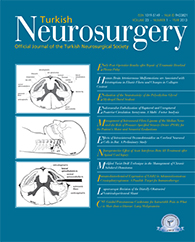2Clinical Hospital of Ministry of Internal Affairs and Administration, Department of Neurosurgery, Warsaw, Poland DOI : 10.5137/1019-5149.JTN.6134-12.1 AIM: Complete aneurysm obliteration reduces the risk of rebleeding and is an important goal of the aneurysm treatment.
MATERIAL and METHODS: A retrospective analysis of 63 patients undergoing endovascular treatment of posterior circulation aneurysms. The occlusion rate was stratified to three groups: complete, incomplete and partial. In the analysis compared the influence of the selected characteristics: age, sex, WFNS grade, aneurysm location, size of the aneurysm dome and neck, neck to dome ratio, on the effectiveness of embolization in each group. A multi-factor analysis with probit model and linear regression was applied to assess the impact of all characteristics on the complete occlusion.
RESULTS: In the series of 63 single aneurysms, 51 were ruptured and 12 unruptured aneurysms. Complete occlusion was achieved in 36 (57.1%), incomplete in 15 (23.8%), partial in 12 (19%) patients. In patients with the neck size of 1-2 mm the complete occlusion was in 75% (24/32) incomplete in 12,5% (4/32), while when the neck size was 2-4 mm these rates were 38.7% (12/31) and 29% (9/31) respectively. The predictor of total occlusion in probit and linear regression model was only one independent variable, the narrow-neck size.
CONCLUSION: Multi-factor analysis found that the strongest predictor of the complete occlusion is the aneurysm neck size.
Keywords : Aneurysm, Coiling, Posterior cerebral circulation




